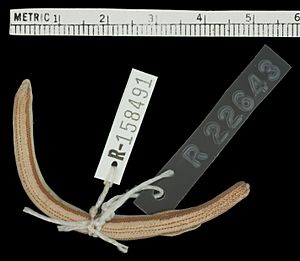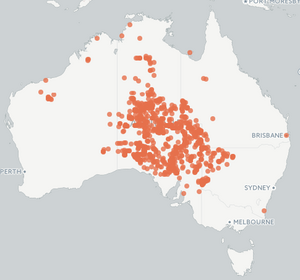Lerista labialis facts for kids
Quick facts for kids Lerista labialis |
|
|---|---|
 |
|
| Conservation status | |
| Scientific classification |
The southern sandslider (Lerista labialis) is a type of skink, which is a kind of lizard. These lizards are found only in Australia and live across the country. They often hide inside sandy termite mounds. This helps them stay safe from the hot Australian weather and animals that might try to eat them.
Contents
What Does It Look Like?
The southern sandslider is a small skink. It has a body and tail that look a bit like a snake. Its color can be red to brown. It also has a darker brown line along its side. It looks very similar to another skink called Lerista bipes.
This skink has no front legs. Its back legs are very small. It has one special scale above its eyes (called a supraocular scale). It does not have the small scales along the edge of its upper eyelid (supraciliaries).
Adult female southern sandsliders are usually longer than males. Females can grow to about 38 to 60 millimeters (about 1.5 to 2.4 inches) long from their snout to their vent (the opening at the base of the tail). Males are a bit smaller, reaching about 37 to 55 millimeters (about 1.4 to 2.2 inches) in length.
Scientific Name
The scientific name for the southern sandslider is Lerista labialis. It was first described by a scientist named Glen Milton Storr in 1971. Over time, scientists have used a few different names for this skink, but Lerista labialis is the one commonly used today.
Where Do They Live?
Southern sandsliders are found across the desert plains of Western Australia, the Northern Territory, western Queensland, and New South Wales.
They are most often found on the tops of sand dunes. This is because these areas have the best temperatures for them. They also have enough food and soft sand. The soft sand makes it easy for them to move around without using too much energy.
How They Live and Their Home
Southern sandsliders are fossorial, which means they live mostly underground. They are also nocturnal, meaning they are active at night. They prefer a body temperature between 21–36 °C (70–97 °F). They live in dunes not just for food, but also to control their body temperature, a process called thermoregulation. The southern sandslider "swims" through the loose sand of termite mounds.
They are common in sandy deserts where there isn't much plant cover on the dune tops. This open space allows them to burrow easily. Dunes offer the perfect temperature for these skinks to survive and also provide their main food source.
Reproduction
Southern sandsliders usually breed during the summer months. They lay eggs with shells between November and February. A female typically lays about two eggs at a time. It is very hard to tell if a southern sandslider is male or female just by looking at it from the outside. Scientists usually need to do an internal check to find out.
What Do They Eat?
Southern sandsliders mostly eat termites. Termites make up at least 78% of their diet! The rest of their diet, about 22%, comes from other small bugs like Hemiptera (true bugs) and Neuroptera (like lacewings). They find their food by looking for it just below the ground surface.
They hunt for termites and other small bugs late at night until early morning. They search both on the surface and just under it. Besides bugs, sandsliders also eat sand. The sand helps them digest their food.
Termites are a very reliable food source for the southern sandslider. When there is more rainfall, the sandsliders benefit. More rain helps Spinifex plants grow more. Spinifex is what termites eat. So, more spinifex means more termites, which then means more food for the southern sandsliders.
Southern sandsliders are not much affected by the changing seasons. However, their food supply depends on rainfall. If needed, they will find other types of prey. They don't need to drink water because they get all the water they need from the food they eat.
Who Are Their Predators?
Southern sandsliders hide in dunes to protect themselves from animals that hunt on the surface. They also hide from the very hot temperatures in their environment. The two main animals that hunt southern sandsliders are the snake Simoselaps fasciolatus and another skink called Eremiascincus fasciolatus.
Threats
Currently, there are no major threats to the southern sandslider. Their protection status is considered "least concerned wildlife," which means they are not in danger of disappearing.



